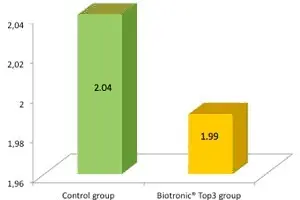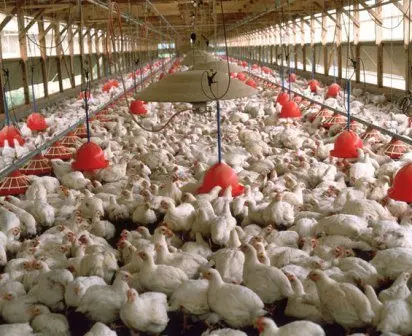How the poultry and livestock industry can benefit from acidifiers
Experts and business leaders within the acidifier market agree on a raising demand for acidifier products, due to population growth and a rising middle class in developing countries resulting in a higher demand for meat. At the same time the requirements for feed for the production of biofuel increase, resulting in a reduced feed supply, increased feed prices, respectively. Therefore, feed additives improving feed utilization will be well demanded in the future. Furthermore, feeding strategies in general seem to shift more and more towards natural, antibiotic-free strategies which are also expected to result in pushing sales numbers for acid based products. Europe is the biggest market for acidifiers and is expected to continue to grow over the next years.
The opinions about the growth potential of the other markets such as Asia, South America or Russia differ. However, there is a mutual consent that propionic acid has the largest potential on the market due to its characteristics as being a readily digestible energy source and active against fungi and bacteria resulting in its characteristics as mould inhibitor. Different levels of agreement exist when it comes to fumaric acid. Some predict that fumaric acid will be less and less important due to its cost and the high optimum dose rate. Others prognosticate that demand will not decrease as fumaric acid is poorly absorbed by the intestine and therefore can pass further along the gastro-intestinal tract. Experts also agree in that formic and lactic acid will play an important role on the acidifier market as they are stronger than fumaric acid. Also the benefits of using organic acid blends instead of single acids will be continuously used in livestock production. However, besides varying the acids within the acid blends and the inclusion levels of the single acids innovations are hard to find. Also the encapsulation of acids is widely discussed. However, encapsulating organic acids eliminates the effects acids exert in feed. Nevertheless, it is important to combat harmful bacteria in the gastro-intestinal tract as well as in feed.
The role of bacterial populations on growth performance
As a matter of fact, animals and plants live in symbiosis with different bacteria, which can protect the host for example from the colonisation of pathogenic bacteria, regulate the development of the gut or produce vitamins and hormones for the host, while some bacteria are also known to cause diseases.
However, the presence of bacteria within the gastro-intestinal tract in general also leads to the competition of the host animal and the bacterial population for nutrients. Bacteria furthermore secrete toxic compounds i.e. toxic amino acid catabolites, decrease fat digestibility, stimulate rapid turnover of absorptive epithelial cells, require an increased rate of mucus secretion by intestinal goblet cells and stimulate immune system development and inflammatory responses. All of these effects lead to impaired growth performance and research has demonstrated that as much as 6% of the net energy in pig diets is lost to the microflora.
Therefore, it is not only highly important to control possibly harmful bacteria, but also to keep the bacterial population within the gut well balanced. Already a long time ago organic acids were identified to be able to alter the gastro-intestinal microflora by reducing in particular acid-intolerant bacterial species such as E. Coli, Salmonella and Campylobacter resulting in increased growth performance. However, it was also shown, that organic acids have stronger effects in the inhibition of gram-positive bacteria. This is due to the structural differences of gram-positive and gram-negative bacteria. In general, the cytoplasm of the cell is surrounded by the cytoplasmic membrane. The cytoplasmic membrane is covered by a thick cell wall layer mainly consisting of peptidoglycan and adjoined by extracellular polysaccharides, teichoic acids and teichuronic acids. The peptidoglycan layer is significantly thinner in gram-negative bacteria compared to gram-positive bacteria. However, gram-negative bacteria are surrounded by an additional outer membrane. This outer membrane provides the bacteria with an inherent resistance to hydrophobic antibiotics and detergents due to the presence and features of lipopolysaccharides in the outer membrane.
Organic acids in combination with other naturally derived products
Often organic acids were combined with other naturally derived products such as essential oils in an attempt to use possible synergisms to more powerful combat pathogenic bacteria. Essential oils in general serve as antioxidants, stimulate the immune system, suppress harmful microorganisms on one side but stimulate beneficial microbes on the other, they regulate the activity of enzymes especially lipase, are known to protect the gut villi and to interfere with the DNA replication of bacterial cells and therefore have anti-bacterial effects. However, the mode of action of different phytochemicals varies a lot. So for example cinnamaldehyde, which is a phytochemical derived from cinnamon bark oil, has an even more complex mode of action. Human as well as veterinary medicine is forcefully searching for drugs targeting the FtsZ protein, as it plays a major role in the cell division of potentially harmful bacteria. FtsZ polymerizes into filaments, which assemble at the place within the cell, where the cell dividison takes place. There they form into a polymeric structure known as the Z-ring on the inner membrane in the mid of the cell, which is responsible for the division of the cell. Cinnamaldehyde inhibits not only the formation of FtsZ into filaments, but also inhibits essential processes involved in the Z-ring formation and its function and thus the cell division. This results in a reduction of the bacterial load, within the gastro-intestinal tract.
Weakening the outer mebrane of gram-negative bacteria
Even if the outer membrane of the gram-negative cell is acting as a protective barrier for external agents it is possible to weaken the outer membrane by agents commonly characterised as permeabilizers. All the permeabilizing substances act quite differently. Some of them remove stabilizing cations from the outer membrane, while others bind to the outer membrane resulting in the loss of barrier function. Others destabilise or disintegrate the outer membrane or displace cations from the outer membrane causing membrane damage. However, when it comes to combining organic acids and permeabilizing substances it is of high importance, that the membrane permeability is increased, which is the case only for a couple of permeabilizing substances. When permeabilizing substances weaken the outer membrane of gram-negative bacteria, the activity of other antimicrobials is increased by facilitating external substances capable of inhibiting or destroying cellular functions when entering into the cells. This leads to synergistic effects when a permeabilizing substance is added to a mixture of organic acids. However, if a synergism can be found highly depends on the right combination of organic acids and permeabilizing substances, as not with each combination a synergism will be found.
Effects on animal performance
The effects on the inhibition of bacterial growth of an acid mixture, combined with a phytochemical and the Biomin perforizing substance - a permeabilizing substance - in vitro was shown in research done at the BIOMIN Research Center in Tulln in Austria. And synergistic effects were found when adding the Biomin perforizing substance to the mixture of organic acids and a phytochemical, indicating that the permeabilization of the outer membrane of gram-negative bacteria facilitates organic acids to penetrate the gram-negative cell destroying cellular functions, leading to cellular death. This was also shown to effect animal growth performance, indicating that the host animal does not have to compete for nutrients with pathogenic bacteria.
Biotronic Top 3 containing an organic acid mixture, a phytochemical and the Biomin perforizing substance at an inclusion rate of 1.0 kg/t feed. The duration of the trial was 56 days.
Biotronic Top 3. Body weight (BW) at day 56 was by 6 % (P<0.05) higher in the trial group compared to the control group (Figure 1). Average daily gain (ADG) was improved by 8% in the Biotronic group compared to the group with no acidifier added (Figure 2) and also feed conversion ratio (FCR) was improved by 3% (P>0.05) in the Biotronic Top3 group compared to the control group (Figure 3). However, differences in FCR were not significant.
Results indicate that the presence of bacteria within the animals’ gastro-intestinal tract highly influences their growth performance. Biotronic Top3 is a new product out of BIOMIN's Biotronic product line, which helps to effectively combat harmful bacteria resulting in improved growth performance in pigs. The Biomin perforizing substance in Biotronic Top3 is a substance unique in acidifier products on the global acidifier market and a “revolution” as it presents a different strategy to act against bacteria. The synergisms caused by the inclusion of the Biomin perforizing substance, allows a reduction in inclusion level, resulting in economical benefits for the end user. BIOMIN added with the creation of Biotronic Top3 a highly innovative product to its portfolio of acidifier products. The unique mode of action of the active ingredients in Biotronic Top3 allows BIOMIN to introduce an outstanding product to the acidifier market, which is in general recognised as being a commodity market.









